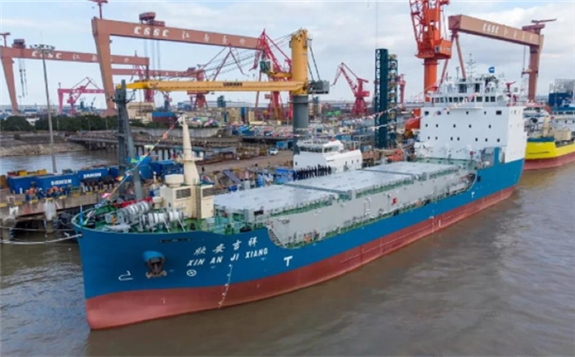China's first ship for the transport of used nuclear fuel has been delivered to China National Nuclear Corporation (CNNC). The independently produced double-hulled vessel meets the INF-3 (Irradiated Nuclear Fuel class 3) standards set by the International Maritime Organisation.

Construction of the ship - named Xin An Ji Xiang - began on 25 September 2019 and it was launched on 15 June this year. It completed sea trials on 26 November. A ceremony was held yesterday to mark the delivery of the vessel from the manufacturer to CNNC.
The ship features a double hull, with multiple watertight transverse bulkheads and reinforced structures for side impacts. It is powered by dual main engines, dual propellers, dual steering engines, and has dual independent cabins. For radiation protection, the ship's design combines heavy concrete, polyethylene and freshwater shielding. It is also equipped with a large-capacity independent cooling system for the cargo holds, a multi-channel composite communication system and an advanced intrusion detection and security system.
"The ship will serve the transportation of used fuel in China's nuclear power plants, contribute to the safety of used fuel transportation and serve the development of nuclear energy, and further consolidate China's ability to guarantee used fuel transportation," CNNC said. "China has become one of the few countries with this technology and capability," it added.
The INF3 class is the highest level of safety in the world for transporting radioactive materials and allows such vessels to carry used nuclear fuel, high-level waste and plutonium with no limit on the maximum aggregate radioactivity of the materials carried.
There are currently at least five small purpose-built ships ranging from 1250 to 2200 DWT, and four purpose-built ships ranging from 3800 to 5000 DWT, that conform to INF-3.
The three largest ships belong to a British-based company, Pacific Nuclear Transport Ltd (PNTL), a subsidiary of International Nuclear Services Ltd. The three PNTL vessels currently in service, the Pacific Heron, Pacific Egret, and Pacific Grebe were launched in Japan in 2008, 2010 and 2010, respectively. Each ship can carry up to 20 or 24 transport casks, weighs 4916 tonnes (DWT) and is 104 metres long. Pacific Grebe carries mainly wastes, whilst the other two usually carry consignments of mixed-oxide fuel. Earlier ships in the PNTL fleet mainly carried Japanese used fuel to Europe for reprocessing.
In 2013, Sweden's SKB commissioned the Sigrid, a slightly larger replacement for its 1982 vessel the Sigyn. It is used for moving used fuel from reactors to the CLAB interim waste storage facility. Sigrid is equipped with a double hull, four engines, and redundant systems for safety and security. It is 99.5 metres long and 18.6 metres wide, 1600 DWT and capable of carrying 12 nuclear waste casks.
Russia's Rosatomflot is operating the 1620 DWT Rossita, built in Italy and completed in 2011. It is designed for transporting used nuclear fuel and materials of decommissioned nuclear submarines from Russian Navy bases in northwest Russia. Rosatomflot also operates the Serebryanka (1625 DWT, 102 metres long, built in 1974). The Imandra (2186 DWT, 130 metres long, built in 1980) is described as a floating technical base but is reported to be in service transporting used fuel and wastes from the Nerpa shipyard and Gremikha to Murmansk. Rossita is an ice-class vessel and is designed to operate in the harsh conditions of the Arctic. The ship is 84 metres long and 14 m wide, has two engines, and two isolated cargo holds with a total capacity of 720 tonnes.
Rosatomflot also operates the semi-submersible pontoon dock Itarus, built in Italy under a 2013 contract, and delivered in 2016. It is designed to transport three compartment units of dismantled Russian nuclear submarines for SevRAO in Saida Bay.